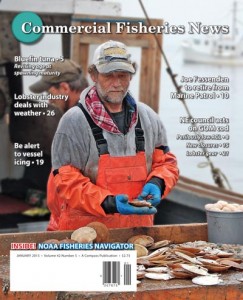
In 2011, when the LPRC moved into its home at the Marine Research Station in Gloucester, Director Molly Lutcavage said of the facility’s huge walk-in freezer, “Guts and gonads. Stomach contents. That’s what we’ll store in here. This makes it a real fish lab.” Gonad analysis was at the heart of the new findings on western Atlantic bluefin spawning age by the Lutcavage team of researchers. (Lorelei Stevens photo)
GLOUCESTER, MA – Years of work by Molly Lutcavage, director of the Large Pelagics Research Center (LPRC) at the University of Massachusetts Amherst Gloucester Marine Research Station, on western Atlantic bluefin spawning age – a key factor in determining stock status – has finally come to fruition.
With her former doctorial student Gilad Heinisch of Israel’s Oceanographic and Limnological Research Center, Lutcavage recently published a study in the online open-access scientific paper section of the journal “Nature” that suggests these fish mature at a considerably younger age than currently assumed.
The findings could lead to changes in how fisheries scientists estimate the size of the western Atlantic bluefin population.
“Realistic fish stock assessments require knowing at what age, where, when, and how often fish spawn,” Lutcavage said.
In their study, Lutcavage and Heinisch, along with former doctoral student Jessica Knapp of the University of New Hampshire, introduced a new endocrine-based approach to determine timing of sexual maturation for western bluefin.
Currently, sexual maturity for bluefin tuna is determined by observing fish sizes on known spawning grounds during known spawning seasons.

Read the rest of this story and much, much more in the January issue of Commercial Fisheries News. Buy this issue or Subscribe.
(Read online immediately with access key and download for future reference.)








 Updating...
Updating...